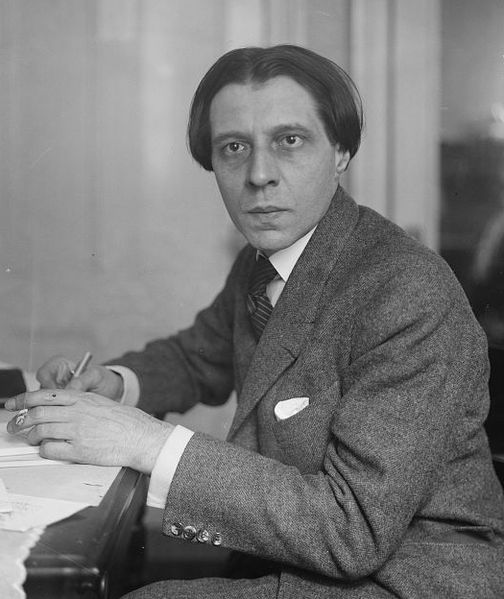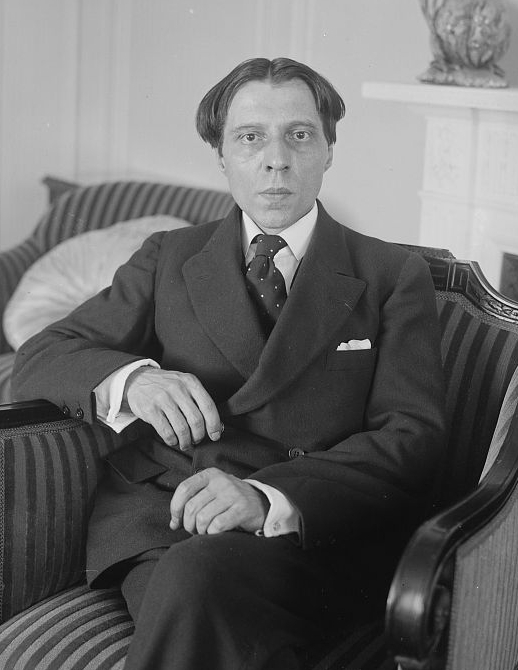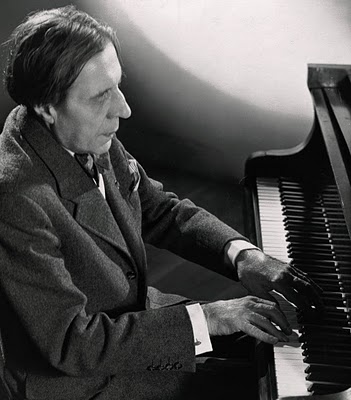<Back to Index>
- Pianist and Conductor Alfred Denis Cortot, 1877
PAGE SPONSOR



Alfred Denis Cortot (26 September 1877 – 15 June 1962) was a Franco - Swiss pianist and conductor. He is one of the most renowned 20th century classical musicians, especially valued for his poetic insight in Romantic period piano works, particularly those of Chopin and Schumann.
Born in Nyon, Vaud, in the French speaking part of Switzerland, to a French father and a Swiss mother, Cortot studied at the Paris Conservatoire with Émile Descombes (an associate and possibly a student of Frédéric Chopin), and with Louis Diémer, taking a premier prix in 1896. He made his debut at the Concerts Colonne in 1897, playing Beethoven's Piano Concerto No. 3. Between 1898 and 1901 he was a choral coach and subsequently an assistant conductor at the Bayreuth Festival. In 1902 he conducted the Paris premiere of Wagner's Götterdämmerung. He formed a concert society to perform Wagner's Parsifal, Beethoven's Missa solemnis, Brahms' German Requiem, and new works by French composers.
In 1905, Cortot formed a trio with Jacques Thibaud and Pablo Casals, which established itself as the leading piano trio of its era. In 1907, he was appointed Professor by Gabriel Fauré at the Conservatoire de Paris, replacing Raoul Pugno. He continued to teach at the Paris Conservatoire until 1923, where his pupils included Clara Haskil, Yvonne Lefébure, Dinu Lipatti, Vlado Perlemuter, Simone Plé - Caussade, and Marguerite Monnot.
In 1919 Cortot founded the École Normale de Musique de Paris. His courses in musical interpretation were legendary. His notable students at that school included Elisha Abas, David Barnett, Victor Bouchard, Mario Braggiotti, Charles Bruck, Dino Ciani, Clotilde Coulombe, Halina Czerny - Stefańska, Jean - Michel Damase, Gunnar de Frumerie, Karl Engel, Renaud Gagneux, Eric Gaudibert, Ilmari Hannikainen, Clara Haskil, Václav Kaprál, Yvonne Lefébure, Raymond Lewenthal, Jerome Lowenthal, Jean - Pierre Marty, Marguerite Monnot, Vlado Perlemuter, Helena Sá e Costa, Pnina Salzman, Esteban Sánchez and Magda Tagliaferro.
As a leading musical figure, Cortot traveled for many international
music events. The French government sponsored two promotional tours to
the United States, and one to the new Soviet Russia in 1920. He
conducted several orchestras and was often called upon to provide piano
accompaniment for touring artists when in Paris. Involved in music until
his health failed, like Franz Liszt
in his advanced years he taught master classes in piano. (Excerpts from
these classes can be found on CD, and on the DVD "The Art of the
Piano.") He died in Lausanne, Switzerland.
Controversially, he supported the German occupation of France during the Second World War and the Vichy regime that ruled part of the country during that period. He was even a member of the Conseil national ("National Council"), a non - elective consultative body of the Vichy government, which included a number of former members of the French parliament and non - political celebrities. Cortot played in Nazi - sponsored concerts in Germany itself, and served as Vichy's High Commissioner of the Fine Arts. His Vichy connections led to him being declared persona non grata after the Liberation.
The motives for his wartime activities have been disputed: they may
have arisen from nothing more than his lifelong championship of Teutonic
musical culture. Moreover his wife, Clothilde Breal, daughter of the
linguist Michel Breal, was of Jewish origin and Clothilde Breal's
cousin, Lise Bloch, was married to Léon Blum,
the first Jew to become President du Conseil or Prime Minister in
France. Cortot and the Blums maintained a close friendship. At any rate,
he was banned from performing publicly for a year
and his public image in France suffered greatly (though he continued to
be well received as a recitalist in other countries, notably Italy and
England).
As one of the most celebrated piano interpreters of Chopin, Schumann, and Debussy, Cortot produced printed editions of all of those composers' music. His editions were notable for their inclusion of meticulous commentary on technical problems and matters of interpretation.
Cortot suffered from memory lapses in concert (particularly notable from the 1940s onwards), and occasionally left wrong notes on his records. However, when Cortot was in form, he showed a brilliant technique that could handle almost any kind of pianistic firework. This gift is evident in his legendary recordings of Liszt's Sonata in B minor (the first recording ever made of this masterwork) and Saint - Saëns' Etude en forme de valse. The latter thoroughly impressed even Vladimir Horowitz, who approached Cortot to learn his "secret" in performing it; Cortot, however, did not divulge it to him.
Cortot also wrote a good deal of didactic prose, including a piano primer: Rational Principles of Pianoforte Technique. This book contains many finger exercises to aid in the development of various aspects of piano playing technique. It was originally written in French but has long since been translated into other languages.
Technical flaws notwithstanding, Cortot was among the very greatest musicians of the century and represented "the end of an era." He is considered one of the last exponents of a personal, subjective style that deprecated precise technique in favor of intuition, interpretation, and authentic spirit. This approach was replaced by the modern "scientific" way of playing, which places logic and precision at the forefront and equates authenticity with exact and literal interpretations. Cortot's recordings and musical annotations have seldom been out of print.
In the 1920s, Cortot recorded a number of piano rolls for the Aeolian / Duo-Art company, since 78 rpm discs were not always satisfactory in quality or maximum duration of the recording. Once he performed a Liszt Rhapsody weaving his own playing live at the piano with its mechanical reproduction. With eyes closed, some critics could not distinguish between the two. In later years Cortot of course switched to disc technology, and he recorded right up to 1957, only five years before his death. In addition to his many recordings of works by Chopin, Schumann, and Liszt, he made important recordings of music by Weber, Mendelssohn, Franck, Debussy and others, and conducted the first complete recording of the Brandenburg Concertos, in which he performed the lengthy solo cadenza of the fifth concerto on a modern piano. He is also famous for his many chamber music recordings with Jacques Thibaud and Pablo Casals and his accompaniment of singers such as Maggie Teyte and Charles Panzéra. Cortot's final, post war solo recordings are marred by more frequent errors, but he retained his specially eloquent phrasing and the free, Romantic performing manner for which he was famous.
Other notable pupils of Cortot during his later years included Samson François and Esteban Sánchez.